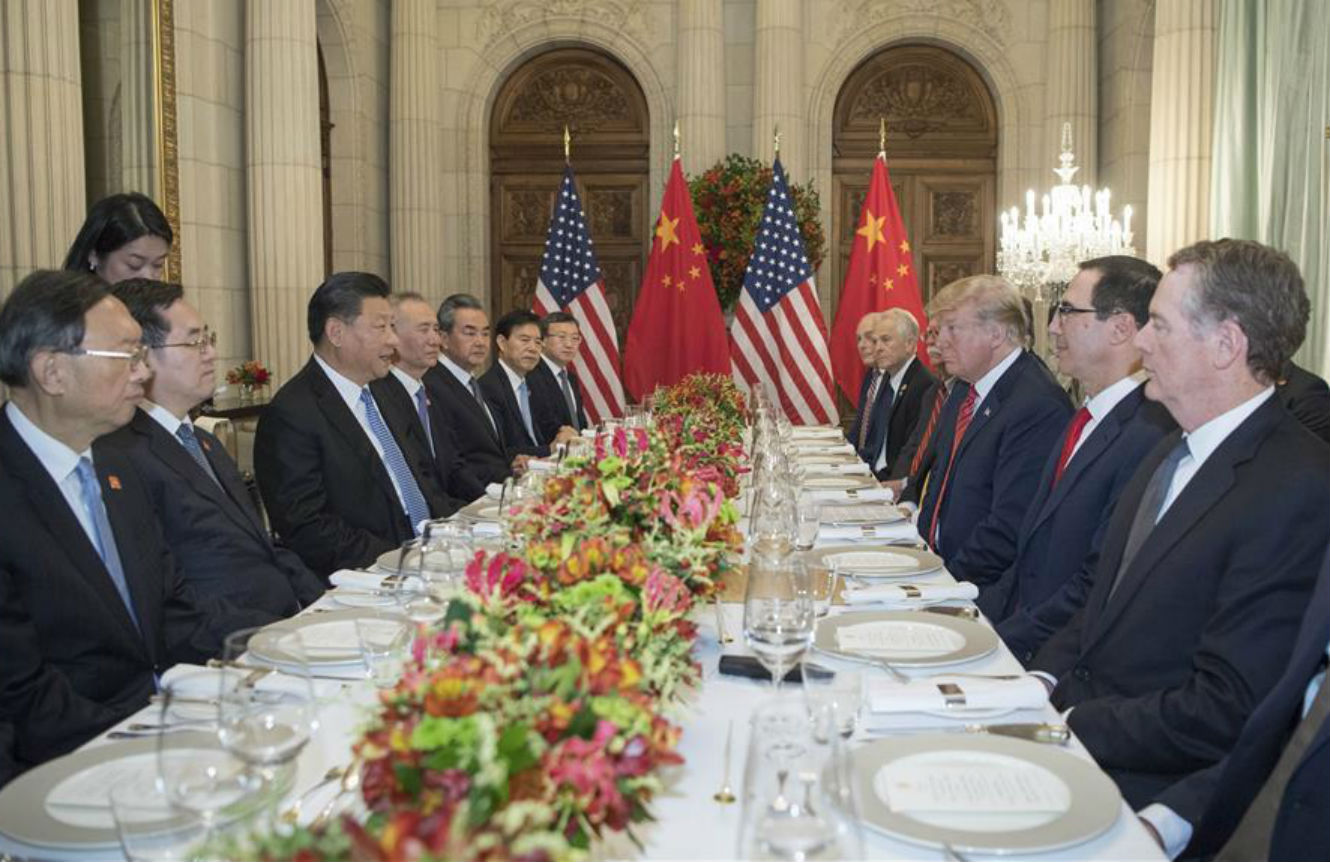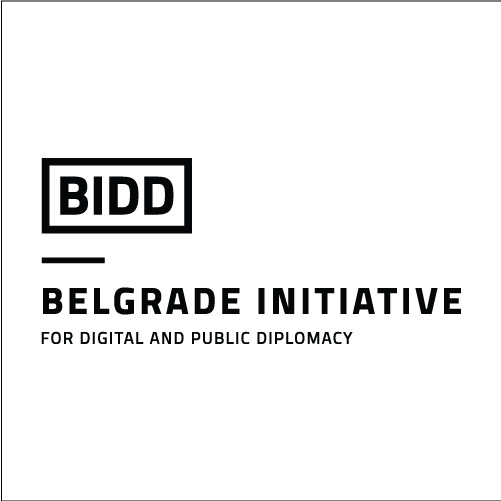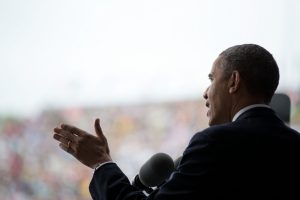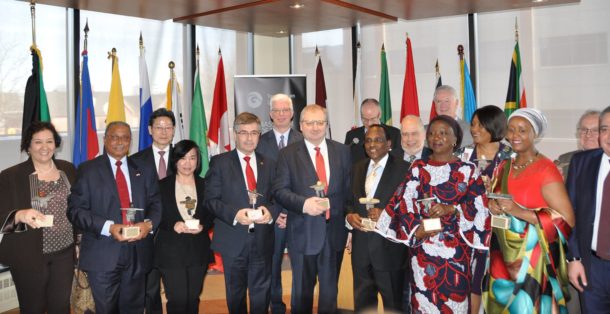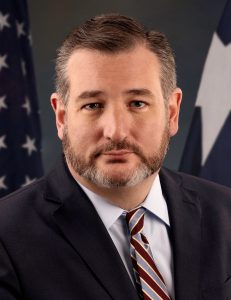Job C. Henning, warontherocks.com; original article contains links uncaptioned Xinhua image from article
uncaptioned Xinhua image from article
Excerpt:
To redirect its relationship with Beijing, the United States should try something fundamentally new and unexpected: launch an effort aimed at encouraging China’s westward interest in the rest of Eurasia.
It could include a three-pronged initiative: The first two would be dramatic departures from current U.S. policy: American participation in China’s Belt and Road Initiative and membership in its multilateral financial institution, the Asian Infrastructure Investment Bank. These would create initial valuable opportunities for U.S.-Chinese investment and development. Such collaboration could then supplemented with a reorganized Trans-Pacific Partnership that includes China and the United States and is enlarged to focus beyond the Pacific Rim to new emerging trade zones in central Eurasia.
The Belt and Road Initiative is focused on an area that is home to over one third of the current global population and roughly the same volume of global economic activity. Evocative of the old “Silk Road,” which China’s Han Dynasty imperial envoy Zhang Qian is credited in China with pioneering in the second century BC, the idea of the Belt and Road Initiative appeals to the imagination of many of the populations along its various routes as few policy initiatives could. American companies GE, Caterpillar, and Honeywell already have multibillion-dollar businesses with Belt and Road projects. Such projects could become long-term driver of U.S. goods and services. However, without official U.S. engagement, American companies risk being exploited and marginalized as China becomes more sophisticated at replicating the products and services currently being offered by these U.S. firms.
There are many critics of the Belt and Road Initiative who dismiss it as an unfunded public diplomacy [JB emphasis] gesture or characterize it as primarily an effort to counter U.S. interests. The U.S.-China Security and Economic Review Commission report to Congress earlier this month indulges in fact-free ideological extrapolations about how the People’s Liberation Army “might” be tempted to use Belt and Road Initiative as an excuse to project power.
There is no question that there are many ways in which American and Chinese interests conflict beyond trade, from the South China Sea, to anti-access strategies around Taiwan and new capabilities in artificial intelligence and space. Further, U.S. treaty obligations to Japan and South Korea require it to defend these allies against any attempt by China to threaten their territory and autonomy. Any actual collaboration between the United States and China would need to be carefully reviewed. However, this initial proposal by Washington to Beijing does not require any change to U.S. security posture towards China and is compatible with a wide range of views of U.S.-Chinese relations and interests today.
Whereas before, critics may have debated whether the United States was even up to such an effort, this is clearly no longer the case with the recent passage of the BUILD Act in the U.S. Congress. With this new legislation, the U.S. government is about to get a supersized capability to support the financing of American investment abroad: the U.S. International Development Finance Corporation. With a lending capacity of $60 billion, it is roughly twice the size of the current U.S. Overseas Private Investment Corporation. Plus, it now has the ability to make equity investments. All of this could be used to attract and leverage private capital through public private partnerships on an even much larger scale.
While the Obama administration declined to join the Asian Infrastructure Investment Bank when it was created, Xi has reiterated on several occasions that membership in the bank remains open to the United States. Established with extensive input from private American legal advisors and international financial institutions, the bank is proving thus far to be a transparent and effective lending institution — contrary to early fears expressed by its two main critics, Japan and the United States. Japan was primarily concerned about competition with the Asian Development Bank and the United States originally viewed the effort as an to rival the World Bank. Over the past several years, skeptics have increasingly come to see Asian Infrastructure and Investment Bank simply as a way to expand available financing for infrastructure in a developing part of the world that has not previously received sufficient attention. The United States is only ceding influence in Eurasia by not being a member.
After Trump removed the United States from the Trans-Pacific Partnership negotiations, the 11 other countries proceeded to complete negotiations on their own. The agreement came into force at the end of October as the Comprehensive and Progressive Trans-Pacific Partnership. Trump has reportedly instructed aides to investigate the potential benefits of rejoining this initiative if different terms could be arranged.
This collaboration between China and the United States on infrastructure development would be disruptive in the sense it would be entirely contrary to what China would expect and it would be intended to at least temporarily reorder the agenda and expectations in U.S.-Chinese relations. Even if it only served the short-term goal of creating breathing room between the countries on the trade crisis, it would be successful. If nothing else came of the gambit, the United States could then decide to pivot back to business as usual. Nothing would be lost.
However, if the overture demonstrated incremental results, this “disruptive collaboration” could develop an expanded bilateral agenda between the countries that could defuse tension and expand win sets — all the while allowing the two leading global powers to associate themselves with beneficent goals that broadly advance the interests of developing nations. This would not require an American return to the apparently deceased “responsible stakeholder” approach to China, but could lead to a more practical accommodation of interests in pursuit of elusive “trans-continental equilibrium.”
In most auspicious circumstances, the disruptive collaboration could be used to make it more difficult for countries in the heart of Eurasia to collude against American interests by increasing the coherence of U.S. policies towards the region. Washington’s approach towards the continent has historically addressed the Pacific Rim, South Asia, the Middle East, and the trans-Atlantic community separately. This has unnecessarily augmented Russian and Iranian freedom of action to work against U.S. interests in Europe and the Middle East. In Western Europe, it leaves the United States overly dependent on the uncertainties of the coherence of Europe and European political will on security investments. In East Asia it continues to lock the United States into intractable strategic challenges over the Korean peninsula and Taiwan where American and Chinese perspectives and interests conflict too much to enable any real resolution or sustainable solution.
Ultimately, in the worst-case scenario, this attempt to change the subject could buy some time in the trade dispute with China. In the best case scenario, the initial overture could evolve into a larger strategy, giving the United States a hand in helping catalyze and shape the future of global growth and trade, extending the course and duration of its own global influence. And if all else still fails in the bilateral relationship, this approach would serve as a hedge, having allowed the United States to “keep China close” in the time period prior to any tectonic rupture, diluting its role as a convener in Eurasia and allowing it to gain a better understanding of mindsets and interests.
Job C. Henning is CEO of Grid Energy and Partner in Auxano Strategies, companies that promote and develop sustainable energy initiatives. He is a Fellow in the Asia-Pacific Mansfield Society at the University of Montana and former co-director of the U..S. Congressional Commission the Project on National Security Reform. Earlier in his career he worked in Eurasian strategic futures for the Office of the Secretary of Defense and the National Intelligence Council.
Original Article
Public diplomacy John Brown's Public Diplomacy Press and Blog Review Change the Subject: U.S.-China Relations After Buenos Aires


